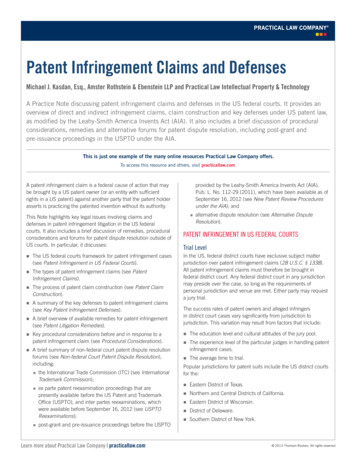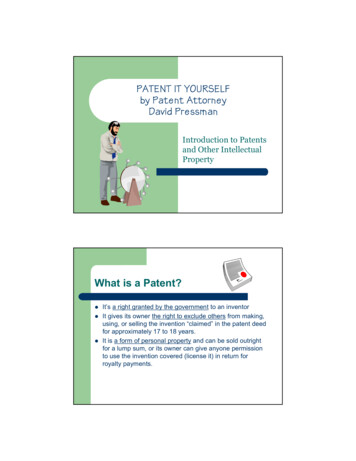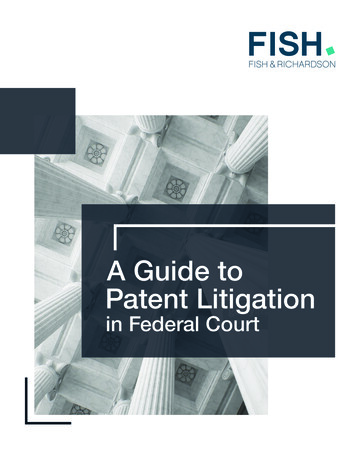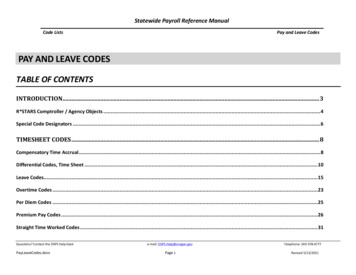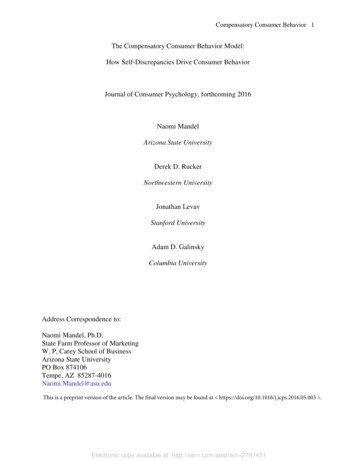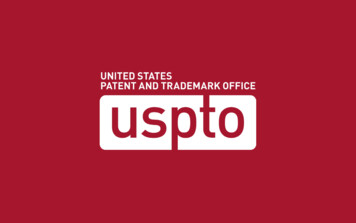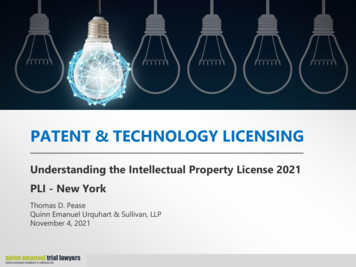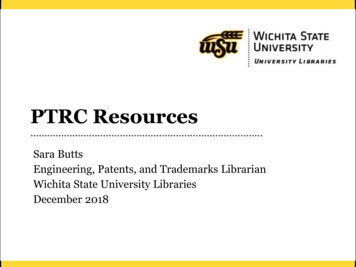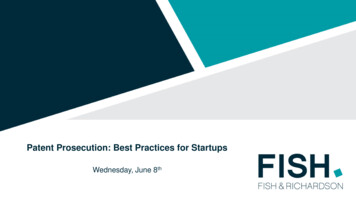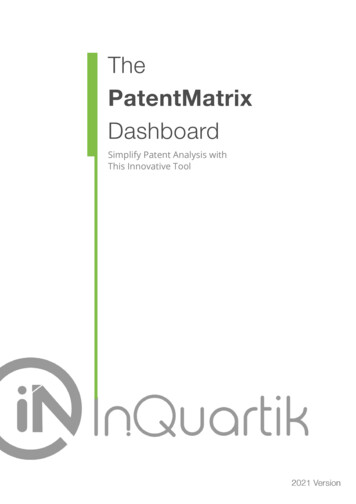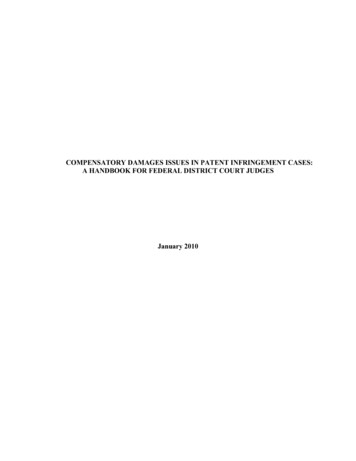
Transcription
COMPENSATORY DAMAGES ISSUES IN PATENT INFRINGEMENT CASES:A HANDBOOK FOR FEDERAL DISTRICT COURT JUDGESJanuary 2010
TABLE OF CONTENTSPage(s)I.PATENT DAMAGES IN GENERAL. 2A.Statutory Provisions . 2B.Forms of Compensatory Patent Damages. 3C.1.Lost Profits . 32.Reasonable Royalty . 43.Established Royalty . 3Burdens, Methods and Standards of Proof . 5II.PLEADINGS AND MANDATORY INITIAL DISCLOSURES. 6III.DISCOVERY . 8IV.V.VI.A.Phased Discovery . 8B.Protective Orders. 11C.Limits on Depositions. 14D.Document Retention and Production . 15E.Mandatory Final Disclosures and Supplementation. 17SUMMARY JUDGMENT MOTIONS . 17A.Timing of Summary Judgment on Damages . 17B.Potential Damages Issues Amenable to Summary Disposition . 18PRE-TRIAL CASE MANAGEMENT . 20A.Pretrial Conference and Order . 20B.Daubert Motions . 21C.In Limine Motions. 24TRIAL . 25A.Separate Trials. 25i
VII.B.Voir Dire . 27C.Procedures to Aid the Jury’s Understanding . 27D.Objections . 27E.JMOL At the Close of Evidence . 28F.Verdict Forms . 28POST-TRIAL . 29A.Renewed JMOL Motions, Motions for New Trial & Remittitur . 29B.Ongoing Royalties. 30C.Findings of Fact and Conclusions of Law . 31ii
INTRODUCTIONChief Judge Paul R. Michel of the United States Court of Appeals for the Federal Circuitasked the members of this Project to come together to develop a handbook for trial courts toconsult when deciding issues of compensatory damages in patent infringement cases. The goalwas to create a handbook drafted by a committee, national in scope, with members from thebench, bar and academia, including in-house counsel from a variety of industries, and patentdamages experts. The underlying idea was to benefit from the collective experience of judges,attorneys, academics and economists in how best to achieve the “just, speedy and inexpensivedetermination”1 of patent damages. Recognizing that patent damages law is an area thatcontinues to evolve, this handbook is not an attempt to restate substantive damages law or predictits future evolution but is instead focused on procedural practices that may be helpful in theadjudication of patent damages.The following procedural practices have not been reviewed or endorsed by the UnitedStates Court of Appeals for the Federal Circuit or any judge of that court. The Chief Judge didnot participate in the drafting, although two district judges did actively participate. Thesepractices are not intended to be “official” in any sense. Nor does any particular member of thisCommittee, or the company, law firm, law school, or client that employs that member, or thecourt on which that member serves, or organization with which that member is affiliated, endorsethe application of any particular practice in any particular case. Nor is this handbook intended tosuggest that current law needs or does not need judicial or legislative revision. Rather, thisbenchbook is intended to be a helpful resource for judges and lawyers under current law.In compiling this handbook of practices, we have looked to and drawn from the work ofothers, including the Federal Judicial Center’s Patent Case Management Judicial Guide,2 theNational Jury Instruction Project,3 and the local patent rules, standing orders and general ordersof various district courts. Recognizing that “the rich variety of cases and the benefits of theexercise of informed judgment and discretion of district court judges require flexibility,”4 judgesand lawyers who consult this handbook will need to supplement and tailor the practices andapproaches discussed herein to the circumstances of their particular case.1 Fed. R. Civ. P. 1. Unless otherwise indicated, all references in this handbook are to the Rules are to the FederalRules of Civil Procedure.2 Peter S. Menell, Lynn H. Pasahow, James Pooley & Matthew D. Powers, PATENT CASE MANAGEMENT JUDICIALGUIDE, http://www.fjc.gov/library/fjc catalog.nsf (2009) (“PATENT MANAGEMENT GUIDE”).3 The National Jury Instruction Project, MODEL PATENT JURY rg (2009) (“Model Patent Instructions”).4 PATENT MANAGEMENT GUIDE, supra note 2, at 1-1.1
I.PATENT DAMAGES IN GENERALAlthough this benchbook is not intended to be a comprehensive treatise on patentinfringement compensatory damages or a definitive interpretation of extensive judicial precedenton the subject, it is helpful to briefly set forth the framework and context for the proceduralpractices described later.A.Statutory ProvisionsSection 284 of the patent statute addresses damages, both compensatory and enhanced.The portion directed to compensatory damages states:5Upon finding for the claimant the court shall award the claimant damagesadequate to compensate for the infringement but in no event less than areasonable royalty for the use made of the invention by the infringer, togetherwith interest and costs as fixed by the court. When the damages are not found bya jury, the court shall assess them. . . .The court may receive expert testimony as an aid to the determination of damagesor of what royalty would be reasonable under the circumstances.6Awarding compensatory patent infringement damages through litigation attempts toassess “the difference between the [patentee’s] pecuniary condition after the infringement, andwhat his condition would have been if the infringement had not occurred.”7 The question to beasked in determining such damages is “had the Infringer not infringed, what would [the] PatentHolder . . . have made?”85 The patent statute also affords the patent owner the opportunity to obtain damages enhanced up to treble damages,attorney fees, costs and prejudgment interest, 35 U.S.C. §§284-85, and, to the owner of a design patent, theinfringer’s total profits. 35 U.S.C. §289. In addition, the patent statute affords an additional compensatory damagesremedy for design patents. See 35 U.S.C. §289. These topics are beyond the scope of this paper.6 35 U.S.C. 284.7 Aro Mfg. Co. v. Convertible Top Replacement Co, 377 U.S. 476, 507 (1964), quoting Yale Lock Mfg. Co. v.Sargent, 117 U.S. 536, 552 (1886).8 Aro, 377 U.S. at 507.2
B.Forms of Compensatory Patent DamagesCompensatory patent damages traditionally have fallen into three categories, one or all ofwhich may be involved in a particular case:9 lost profits; established royalty, 10 and reasonableroyalty.11 In addition, the court may award pre-judgment interest under 35 U.S.C. §284 on thecompensatory portion of the damages award,12 pre-judgment interest on any award of attorneyfees,13 and post-judgment interest under Fed. R. Civ. P. 37 on the entire award.141.Lost ProfitsLost profits normally are proved by determining what profits would have been made bythe patentee “but for” the infringement.15 That is, to obtain lost profits damages, the patentowner “must show a reasonable probability that, ‘but for’ the infringement, it would have madethe sales that were made by the infringer.”16 An accepted, but not exclusive, test for lost profitsdamages requires that the patent owner establish: “(1) demand for the patented product; (2)9 State Indus., Inc. v. Mor-Flo Indus., Inc., 883 F.2d 1573, 1577 (Fed. Cir. 1989) (award split between lost profitsand reasonable royalty).10 Although sometimes characterized as a reasonable royalty, see Monsanto Co. v. McFarling, 488 F.3d 973, 978(Fed. Cir. 2007), the established royalty is, strictly speaking, a form of actual damages, and is “reasonable” in thesense that it typically provides the “best measure” of a royalty for the use made of the invention. Id. The relativelyrigorous requirements for finding an established royalty based on previous license agreements, see, e.g., Rude v.Westcott, 130 U.S. 152, 165 (1889), do not apply to the use of such license agreements in the reasonable royaltyanalysis. See, e.g., Lucent v. Gateway, 580 F.3d at 1325-26 (applying comparability standard).11 A fourth form of compensatory damages, the infringer’s profits from the infringement, was eliminated by statutein 1946 for all but design patents. See Aro, 377 U.S. at 505.12 General Motors Corp. v. Devex Corp., 461 U.S. 648 (1983) (pre-judgment interest award is the norm); GroupOne Ltd. v. Hallmark Cards, Inc., 407 F.3d 1297 (Fed. Cir. 2003) (pre-judgment interest may be denied);Underwater Devices, Inc. v. Morrison-Knudsen Co., 717 F.2d 1380 (Fed. Cir. 1983) (no pre-judgment interest onenhanced damages portion).13 Mathis v. Spears, 857 F.2d 749 (Fed. Cir. 1988) (pre-judgment damages may be awarded on attorney fees).14 Tronzo v. Biomet, Inc., 318 F.3d 1378 (Fed. Cir. 2003) (post-judgment interest). Where willful infringement isfound, the court may enhance the amount of damages awarded up to three times under 35 U.S.C. §284. See In reSeagate Technology, LLC, 497 F.3d 1360 (Fed. Cir. 2007) (en banc). If the case is adjudged to be “exceptional,”attorneys fees (in addition to costs) may be awarded to the prevailing party. 35 U.S.C. §285.15 Rite-Hite Corp. v. Kelley Co., 56 F.3d 1538, 1545 (Fed. Cir. 1995) (en banc); BIC Leisure Prods. v. WindsurfingInt’l, 1 F.3d 1214, 1218 (Fed. Cir. 1993).16 Rite-Hite, 56 F.3d at 1545.3
absence of acceptable non-infringing substitutes; (3) manufacturing and marketing capability toexploit the demand; and (4) the amount of profit it would have made.”172.Established Royalty“When the patentee has consistently licensed others to engage in conduct comparable tothe defendant’s at a uniform royalty, that royalty is taken as established and indicates the termsupon which the patentee would have licensed the defendant’s use of the invention.”18 Proof ofan established royalty normally requires a showing that it was the patentee’s regular practice togrant licenses to third parties to authorize conduct of the kind engaged in by the infringer at anestablished royalty rate.19 In this context, the Supreme Court has rejected consideration oflicenses entered into as a result of litigation.203.Reasonable RoyaltyIn almost every patent case, the patent owner seeks reasonable royalty damages, eitherfor infringement for which it cannot prove lost profits or established royalty damages, or as analternative damages theory.21 One approach to calculating reasonable royalty damages is todetermine what a willing licensee in the place of the infringer reasonably would have paid andwhat a willing licensor in the place of the patentee reasonably would have accepted for the grantof a license, had such a license been negotiated just before the infringement began, with bothparties assuming the patent was valid, enforceable and infringed.22The hypothetical negotiation analysis may consider a wide range of evidence, and thefactors to which that evidence may relate include what are referred to as the Georgia-Pacific17 Id.18 Monsanto, 488 F.3d at 978, citing Birdsall v. Coolidge, 93 U.S. 64, 70 (1876) (established royalty furnishes bestmeasure of damages); Nickson Indus., Inc. v. Rol Mfg. Co., 847 F.2d 795, 798 (Fed. Cir. 1988) (absent proof ofunusual circumstances, such as widespread infringement that artificially depressed established royalty, establishedroyalty is best measure of damages); Hanson v. Alpine Valley Ski Area, Inc., 718 F.2d 1075, 1078 (Fed. Cir. 1983)(same).19 Rude v. Westcott, 130 U.S. at 165.20 Id.21 A damages award may consist of lost profits for a portion of the accused infringements and reasonable royalty forthe remainder of the infringements. See TWM Mfg. Co. v. Dura Corp., 789 F.2d 895, 898 (Fed. Cir. 1986). Forexample, this approach is commonly applied where the patent owner seeks to prove lost profits based on marketshare. See State Indus. v. Mor-Flo, 883 F.2d at 1577.22 Rite-Hite, 56 F.3d at 1554. That is not to say that the “analytical method” is not considered in the context of ahypothetical negotiation; it may well be.4
factors.23 That evidence is not necessarily limited to facts predating the date of the hypotheticalnegotiation; in certain circumstances, “factual developments occurring after the date of thehypothetical negotiation can inform the damages calculation.”24 There is “no formula by whichthese factors can be rated precisely in the order of their relative importance or by which theireconomic significance can be automatically transduced into their pecuniary equivalent.”C.Burdens, Methods and Standards of ProofThe amount of patent infringement damages is a question of fact.25 The patentee has theburden of proving damages26 and must do so by a preponderance of the evidence.27 Whatevertheory is pursued, patent infringement is a tort, and as with all tort damages, the aggrieved partyhas the burden of proving both that the economic harm was reasonably foreseeable and causedby the infringer.28The ultimate burden of proof on damages subsumes burdens on subsidiary issues. Forexample, the patent owner has the burden to justify application of the “entire market valuerule.”29The patentee’s burden in establishing patent damages has been described as “a burden ofreasonable probability.”30 Courts recognize that “any reasonable royalty analysis ‘necessarilyinvolves an element of approximation and uncertainty.’”31 Regardless of the form of damages,23 In Georgia-Pacific Corp. v. U.S. Plywood Corp., 318 F. Supp. 1116, 1120-21 (S.D.N.Y. 1970), the courtcompiled fourteen evidentiary factors and a fifteenth factor that, taken together, restate the hypothetical negotiationmethodology from “a conspectus of the leading cases.”24 Lucent v. Gateway, 580 F.3d at 1333-34, citing Sinclair Refining Co. v. Jenkins Pet. Process Co., 289 U.S. 689,698 (1933).25 Smithkline Diagnostics, Inc. v. Helena Laboratories Corp., 926 F.2d 1161, 1164 (Fed. Cir. 1991).26 Id.; see also Blake v. Robertson, 94 U.S. 728, 733 (1876) ("Damages must be proved; they are not to bepresumed."); Lucent v. Gateway, 580 F.3d at 1324 (“The burden of proving damages falls on the patentee.”).27 Vulcan Eng’g Co. v. Fata Aluminium, Inc., 278 F.3d 1366, 1376 (Fed. Cir. 2002).28 Coupe v. Royer, 155 U.S. 565, 582 (1895) (patent infringement damages are the pecuniary losses that the patentowner “has suffered from the infringement”); King Instrument Corp. v. Perego, 65 F.3d 941, 948 n.3 (Fed. Cir.1993) (economic harm limited by foreseeability); Rite-Hite, 56 F.3d at 1546 (same).29 Lucent v. Gateway, 580 F.3d at 1336 (“For our entire market value rule to apply, the patentee must prove that ‘thepatent-related feature is the basis for customer demand.’”).30 Lam, Inc. v. Johns-Manville Corp., 718 F.2d 1056, 1065 (Fed. Cir. 1983).31 Lucent v. Gateway, 580 F.3d at 1325, citing Unisplay, S.A. v. Am. Elec. Sign Co., 69 F.3d 512, 517 (Fed. Cir.1995).5
however, the court should not apply any less rigorous standard of admissibility to the evidencethan that required by the rules of evidence32 or any less rigorous standard to the proof of facts.Speculation is not evidence.33 Courts should allow damage awards based only on “soundeconomic and factual predicates.”34II.PLEADINGS AND MANDATORY INITIAL DISCLOSURESBecause Rule 8(a)(3) requires only “a demand for the relief sought, which may includerelief in the alternative or different types of relief,”35 patent infringement complaints rarely assertthe damages claim in any more detail than that shown by the form Complaint for PatentInfringement: a request “for damages.”36Any lack of specificity in the complaint may well be overcome by the requirement ofRule 26 that the patent owner voluntarily provide damages information and documents as part ofits initial disclosures. The rule states:(A) In General. Except as exempted by Rule 26(a)(1)(B) or as otherwisestipulated or ordered by the court, a party must, without awaiting a discoveryrequest, provide to the other parties:.(iii) a computation of each category of damages claimed by the disclosing party— who must also make available for inspection and copying as under Rule 34 thedocuments or other evidentiary material, unless privileged or protected fromdisclosure, on which each computation is based, including materials bearing onthe nature and extent of injuries suffered . . . .”37The amount of detail and precision that is possible to provide in initial disclosures willvary widely from case to case. And there can be practical limits to what can be disclosed early in32 See Crystal Semiconductor Corp. v. Tritech Microelectronics Int’l, Inc., 246 F.3d 1336, 1354-58 (Fed. Cir. 2001)(affirming grant of JMOL on lost profits because expert testimony was “incompetent” and “unreliable,” andaffirming grant of JMOL on price erosion because expert testimony was “unreliable” and “used an inappropriatebenchmark”).33 Lucent v. Gateway, 580 F.3d at 1327.34 Integra Lifesciences I, Ltd. v. Merck KGaA, 331 F.3d 860, 870-72 (Fed. Cir. 2003), rev’d on other grounds, 545U.S. 193 (2005) (reversing denial of JMOL on reasonable royalty where record not clear on date of firstinfringement); Riles v. Shell, 298 F.3d at 1311.35 Fed. R. Civ. P. 8(a)(3).36 Fed. R. Civ. P. Appendix of Forms, Form 18.37 Fed. R. Civ. P. 26(a) (1).6
a case. Patentees often find that they do not know the full nature and extent of a defendant’sinfringing conduct and do not have sufficient information at the outset of the litigation to knowor calculate precisely the damages caused by the alleged infringement.38 As a consequence,patentees often limit their initial damages disclosures to general categories of patent damages,such as “lost profits and reasonable royalty damages.” Moreover, because the accusedinfringer’s profit information, for example, is not typically information a patentee would knowabsent discovery, any initial damages calculations that are provided reasonably may beconsidered preliminary or approximate.At the same time, courts should not accept skeletal initial damages disclosuresuncritically. While courts should recognize that the fair determination of damages requires theuse of the confidential information of both parties, and that each party may require a fair amountof fact discovery before they can understand the other’s information sufficiently to formulateeven “ball park” damages contentions, both sides should be required to provide initial damagesdisclosures that are as complete as is reasonably possible, as well as “high level” documents intheir possession that are likely relevant to a fair assessment of the damages issue.For a patentee, initial disclosures normally would include documents concerning industryand business sales and profitability; market shares; comparable license agreements and royaltyrates related to the patent at issue; and basic marketing, pricing, manufacturing and salesinformation relating to any products or processes that embody the patented invention or arelicensed under the patent, or that compete with or are sold with or as a result of products orprocesses that embody the patented invention or are licensed under the patent. For the accusedinfringer, the documents initially produced should similarly include documents concerninglicense agreements and royalty rates that relate to the accused product or process; basicmarketing, pricing and sales information relating to the accused products; and any non-infringingsubstitutes; as well as information that otherwise may be relied upon to define the royalty rate orbase.Meaningful compliance with the initial damages disclosure requirements can be essentialto the efficient management of the litigation, and courts overseeing damages disclosures shouldbe mindful of the role these disclosures may play in the early resolution of the litigation. Failureto provide good faith damages disclosures and at least “high level” damages discovery at theoutset of the litigation may hinder settlement discussions, delay settlement, and result inunnecessary expenditure of time, money and judicial resources.39 Even where the initial38 See Advisory Comm. note to 1993 Amendment to Fed. R. Civ. P. 269a)(1) (“a party would not be expected toprovide a calculation of damages which, as in many patent infringement actions, depends on information in thepossession of another party or person.”).39 Accused infringers often are unwilling to disclose sales, profits and other business information that isfundamental to the calculation of damages on the ground that it is highly confidential and cannot properly bedisclosed to the patent owner. As explained in Part III (B) below, the best course is for the court to ensure thatconfidentiality of initial disclosures are adequately protected, either by local rule, standing order, or an earlyprotective order.7
disclosures do not lead to an early settlement, they can be useful in developing an efficientdiscovery plan.District courts across the country have recognized the need to require early disclosure ofinitial infringement, non-infringement, invalidity and validity contentions from the parties topatent infringement litigation. These requirements avoid a “shifting sands” approach toinfringement or invalidity that is unfair to the litigants and unnecessarily prolongs the case andincreases costs. Whether by amendment of local patent rules,40 general or standing order, ororders in individual cases, courts should consider also requiring the patent owner to serve initialdamages contentions early in the case and the accused infringer to respond shortly thereafter,ideally at the same time they serve their respective initial contentions on infringement and noninfringement. At the very least, such disclosures should identify the form of damages beingsought (that is, lost profits, reasonable royalty, or established royalty), as well as the nature of theasserted damages base, in order to frame the discovery. Courts may also wish to discuss withcounsel the possibility of consulting with their damages experts or other appropriate analyticalresources in connection with the early disclosures; thoughtfully crafted early damagesdisclosures can be helpful in framing discovery and in maximizing the potential for earlysettlement.III.DISCOVERYA.Phased Discovery“Discovery in patent cases can be exhaustive and exhausting,” a fact that “is onlymagnified by the emerging emphasis on electronic discovery.”41 Full-fledged damagesdiscovery can raise yet another concern: It not only can be expensive and burdensome; itultimately may prove to be unnecessary, either because the case settles before trial or because thepatent is determined to be invalid, unenforceable and/or not infringed.To minimize burden and improve efficiency, courts should consider, as part of the initialcase assessment and scheduling, whether the interests of justice would be served by phasingdamages discovery. For example, after the mandatory Rule 26 damages disclosures and theabove-described initial “top level” damages disclosures from both parties, the court may chooseto stay some or all damages discovery until after the court’s ruling on claim construction.4240 The local patent rules in different jurisdictions vary in their content. For example, while the Northern District ofCalifornia rules address only infringement, invalidity and claim construction, 825695f00730cdd/ FILE/Pat1200-1.pdf, the Eastern District of Texas rules also address willfulness. See United StatesDistrict Court for the Eastern District of Texas, PATENT s/Documents/Appendix%20M.pdf (2007).41 PATENT MANAGEMENT GUIDE, supra note 2, at 4-1.42 Such an order usually would address the timing of consideration of not only compensatory damages, but alsowillfulness and enhanced damages. The latter two topics are beyond the scope of this benchbook.8
Where the court’s ruling on claim construction is not scheduled to occur early in the proceedings,phasing may not be efficient, as damages discovery will take some time and might best beconducted in concert with discovery on the merits. Moreover, limiting initial damages discoveryto “top level” information may or may not give the parties enough basic information aboutdamages to permit meaningful settlement negotiations.43 And while claim constructionsometimes promotes either settlement or stipulation to judgment followed by appeal, or sets acase up for summary adjudication under Rule 56 (thereby obviating the need for damagesdiscovery), a court-ordered hiatus on damages discovery may lead to significant inefficiencies byrequiring an extended period of fact discovery and, perhaps, a delay of trial.44 Clearly, there isno “one size fits all” approach. In each case, as part of the case management process, courtsshould assess the extent to which the parties’ differences as to damages are a barrier toresolution. Where damages are at the heart of the dispute, it actually may make sense toaccelerate rather than defer damages discovery.One benefit of phased discovery is that it allows trial of liability and damages to the samejury, either at the same time or in phases. Some courts, however, opt to bifurcate patentinfringement cases into liability and damages phases for both discovery and trial. Rule 42 givescourts wide discretion to separate issues or claims at trial “[f]or convenience, to avoid prejudice,or to expedite and economize . . . .”45 Damages can be tried by a different jury after all issues ofliability have been finally resolved, both at trial and on appeal.46 Under this approach, the courtcan streamline the case and reduce the burden on judicial resources by trying damages only when(and if) it becomes necessary to do so. As one court explained:In the normal case separate trials of issues is seldom required, but in apatent infringement suit considerations exist which suggest that efficient judicial43 Early damages discovery may, for example, reveal that the potential damages may be less than the expected costof proceeding with or defending the litigation.44 The Northern District of Illinois’ rules establish a fact discovery hiatus that begins 28 days after the exchange ofpatent claim terms and phrases for construction and ends upon the entry of a claim construction ruling. UnitedStates District Court for the Northern District of Illinois, Local Patent Rules, LPR 1.3,http://www.ilnd.uscourts.gov/home/ assets/ documents/Rules/localpatentrules-preamble.pdf.45 Fed. R. Civ. P. 42(b). See Gardco Mfg., Inc. v. Herst Lighting Co., 820 F.2d 1209, 1212 (Fed. Cir. 1987)(“Under Rule 42(b), a district court has broad discretion in separating issues and claims for trial as part of its widediscretion in trial management.”).46 Of course, the court must ensure that any separation order preserves all federal rights to jury trial. Fed. R. Civ. P.42(b). The Seventh Amendment may be implicated where liability and damages are to be tried by different juries, asthe Constitution requires that “a given issue may not be tried by different successive juries.” Blyden v. Mancusi, 186F.3d 252 (2d Cir. 1999); see also United Air Lines, Inc. v Wiener, 286 F.2d 302, 306 (9th Cir.) (on facts presented,“the issues of liability and damages, exemplary or normal, are not so distinct and separable that a separate trial of thedamage issues may be had without injustice.”). In In re Innotron Diagnostics, 800 F.2d 1077, 1084 (Fed. Cir.1986), the Federal Circuit denied a petition for writ of mandate challenging, on Seventh Amendment grounds, thetrial court’s order directing separate trials of the plaintiff’s patent infringement action and defendant’s antitrustcounterclaims. It explained: “‘the
3 B. Forms of Compensatory Patent Damages Compensatory patent damages traditionally have fallen into three categories, one or all of which may be involved in a particular case:9 lost profits; established royalty,10 and reasonable royalty.11 In addition, the court may award pre-judgment interest under 35 U.S.C. §284 on the compensatory portion of the damages award,12 pre-judgment interest on .
